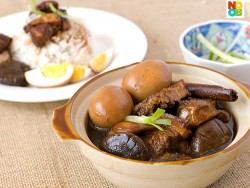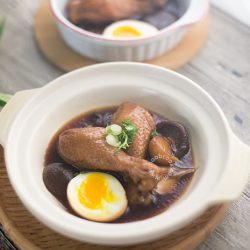Braised Chicken Drumsticks
This Chinese braised chicken drumsticks (滷雞腿) is a simple and homely dish. It is quick to cook as the simmering time is less than an hour. Unlike braised pork, this is not a dish which can withstand a long simmering time, as the chicken skin and meat will start to fall apart – definitely not a pretty sight if the drumsticks are not served intact.
More Braised Dishes:
- Braised Pork Belly (豆油肉) Recipe (above)
- Braised Shiitake Mushrooms Recipe
- Braised Ee-Fu Noodles Recipe
The braised chicken keeps well in the fridge and also reheats easily with the microwave or on the stove, so I always make more for leftovers. As my mum always says, braised food tastes better the next day. I also took the chance to use the leftover sauce to soak and make ramen eggs (eggs with runny yolk) which is a luxurious treat in a humble dish like this.
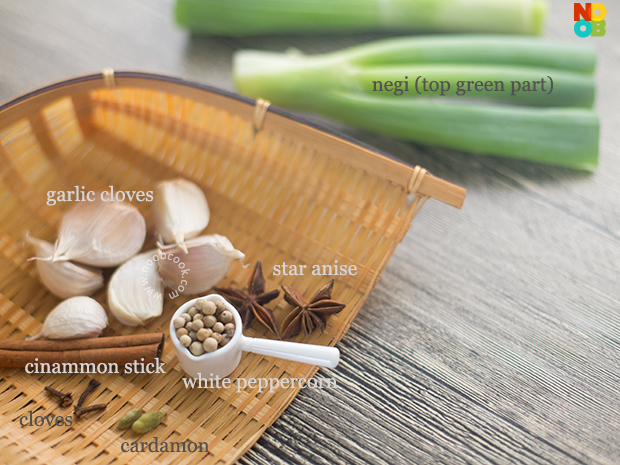
These are the aromatics I used for all my braised dishes. The labels in light colour (garlic, star anise, white peppercorn, cinnamon) are the essentials to me, while the labels in darker colour (cloves, cardamon & green part of negi) are optional but very good to have. Not shown in pic is the 5-spice powder, but just a little bit though. With these aromatics, the rule is that a little goes a long way in a dish like this. Using too much spices will result in overpowering flavours.

This is my casserole before cooking. I try to submerge the chicken and dried mushrooms fully in the sauce, so that the colour and flavours will be even. I also place the small dried ingredients in a disposable soup stock pouch for convenience (discard the pouch when the dish is done).
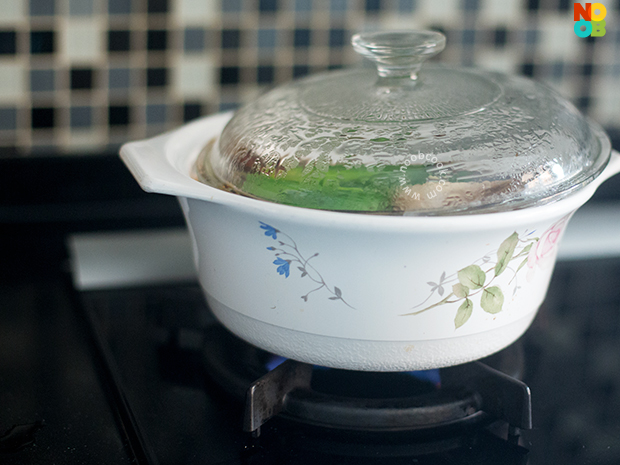
Keep the lid partially open (leave a small opening for ventilation) during simmering. Add hard-boiled eggs during last 10 minutes of simmering.
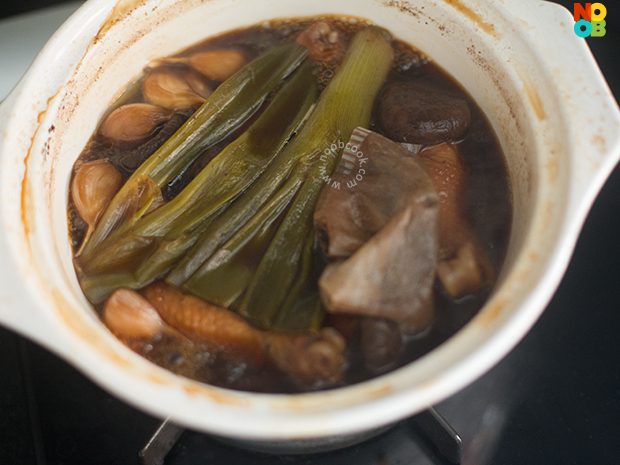
This is the stew when cooked. Discard the negi and disposable soup stock pouch.
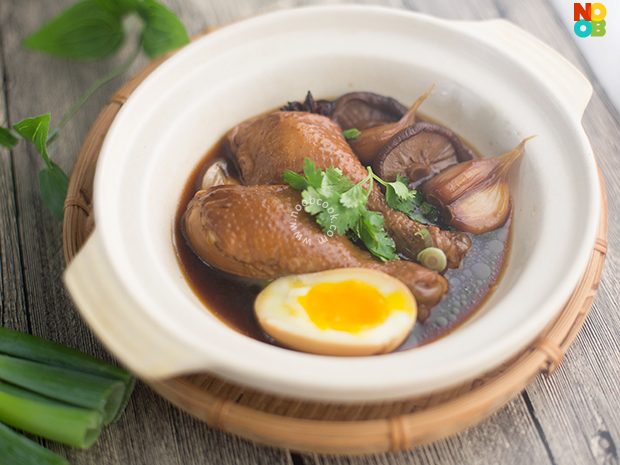
Braised Chicken Drumsticks Recipe
You can also add 1-2 pieces of “tau kwa” (fried beancurd/豆干) during the last 10 minutes of simmering.
Check out the previous page for ingredient and cooking pictures.
Ingredients:
- 6 to 8 skin-on chicken drumsticks
- 4 eggs (or more as desired)
- 750 ml water
- 10 dried shiitake mushrooms soaked in a bowl of hot water until softened, trim & discard stems, squeeze out the excess liquid from caps
- 8 old garlic cloves don’t peel or bruise them
- 2 sections “negi” or Japanese scallion (top green part) optional
- chopped spring onions and/or coriander for garnish
(A) Spices (put inside a disposable soup pouch)
- 2 star anise (八角)
- 1 x 5 cm cinnamon stick (肉桂)
- 1 tsp whole white pepper corn (白胡椒) pounded very slightly
- 3 cloves (丁香) optional
- 2 cardamom (豆蔻) optional
(B) Seasonings
- 1/4 cup (3 tbsp) light soy sauce
- 1/2 tbsp dark soy sauce
- 15 grams rock sugar
- 1/4 tsp 5-spice powder (五香粉)
Directions:
- Blanch chicken drumsticks in a pot of boiling water for 5 minutes. Rinse the chicken pieces and set aside.
- Make the stew. In a pot, add blanched drumsticks, water, dried mushrooms, garlic, negi, spices (A) and seasonings (B). Simmer on low heat with lid partially covered for 40-50 minutes.
- Cook hard-boiled eggs in the meantime. Place eggs in saucepan of cold water (enough water to cover eggs in one layer). Bring to a boil for about 2 minutes, turn off the stove and cover with lid for about 7 minutes. Peel the eggs when cool enough to handle. For making ramen eggs (eggs with runny yolk), refer to this recipe.
- Add eggs & serve. Add cooked hard-boiled eggs during the last 10 minutes of simmering. For ramen eggs, add them only when the stew is cooked and has cooled slightly. Garnish with spring onions or coriander.
Noob Cook Tips
- Variation – If you want marbled eggs (Chinese tea leaf eggs), do not peel the eggs. Instead, gently tap the exterior of the eggs with the back of the spoon to form cracks evenly around the egg, careful to leave the entire shell still intact and covering the egg. This will create the beautiful “marbled” look while allowing the flavours to seep through the eggs.
- The recipe is very forgiving and flexible. Constantly check that the braising sauce is not dried out during the simmering. You will need to add water (a little at a time) if the stew is drying out.
Adjust to taste with dark soy sauce (for colour and sweetness), light soy sauce (for saltiness) and rock sugar for (sweetness).
